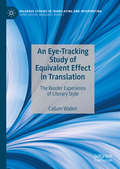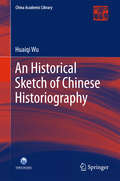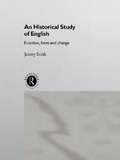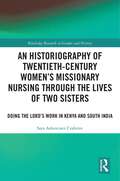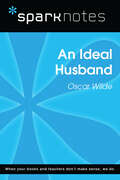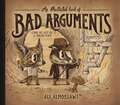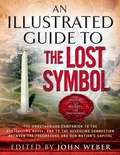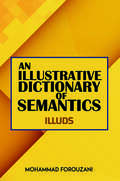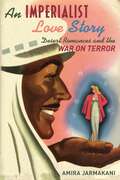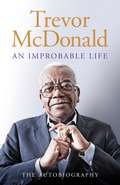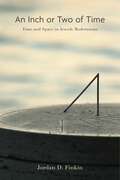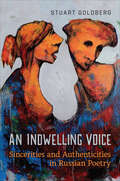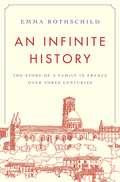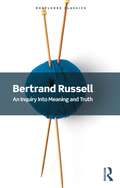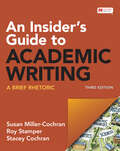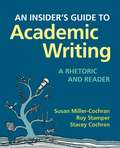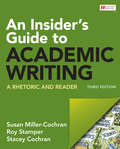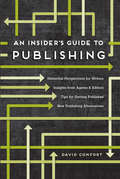- Table View
- List View
An Eye-Tracking Study of Equivalent Effect in Translation: The Reader Experience of Literary Style (Palgrave Studies in Translating and Interpreting)
by Callum WalkerThis book provides a detailed example of an eye-tracking method for comparing the reading experience of a literary source text readers with readers of a translation at stylistically marked points. Drawing on principles, methods and inspiration from fields including translation studies, cognitive psychology, and language and literary studies, the author proposes an empirical method to investigate the notion of stylistic foregrounding, with 'style' understood as the distinctive manner of expression in a particular text. The book employs Raymond Queneau’s Zazie dans le métro (1959) and its English translation Zazie in the Metro (1960) as a case study to demonstrate the proposed methods. This book will be of particular interest to students and scholars of translation studies, as well as those interested in literary reception, stylistics and related fields.
An Historic Tongue: Studies in English Linguistics in Memory of Barbara Strang
by Graham Nixon and John HoneyThis volume, first published in 1988, represents in its papers the wide-ranging yet coherent linguistic interests of the late Barbara Strang (1925-1982). For her, the history of English and its current state were two sides of the same coin, and the principle theme of this collection is that neither one may be properly understood without invoking the other. It is a ‘real-data’ collection, in that its contributors share the view that the facts of language, patiently gathered, recorded and collated, must govern the theory within which they are described, and not vice versa. This philosophy may be seen to operate in all the contributions, and to result in a truly three-dimensional picture of English: data; distribution (temporal, geographical, situational and social); and description. This book will be of interest to students of English language and linguistics.
An Historical Sketch of Chinese Historiography (China Academic Library)
by Huaiqi WuThis book systematically traces the development of Chinese historiography from the 2nd century B. C. to the 19th century A. D. Refusing to fit the Chinese historical narration into the modern Western discourse, the author highlights the significant questions that concern traditional historians, their philosophical foundations, their development over three thousand years and their influence on the intelligentsia. China is a country defined in terms of its history and its historians have worked hard to record the past. However, this book approaches Chinese history from the very beginning not only as a way of recording, but also as a way of dealing with the past in order to orient the people of the present in the temporal dimension of their lives. This book was listed as the key textbook of the "Eleventh Five-year Plan" for college students in China.
An Historical Study of English: Function, Form and Change
by Jeremy SmithThrough his analysis of selected major developments in the history of English, Jeremy Smith argues that the history of the language can only be understood from a dynamic perspective. He proposes that internal linguistic mechanisms for language change cannot be meaningfully explained in isolation or without reference to external linguistic factors. Smith provides the reader with an accessible synthesis of recent developments in English historical linguistics. His book: Looks at the theory and methodology of linguistic historiography . Considers the major changes in writing systems, pronunciation and grammar. Provides examples of these changes, such as the standardisation of spellings and accent and the origins of the Great Vowel Shift Focuses on the origins of two non-standard varieties; eighteenth century Scots and twentieth century British Black English.This book makes fascinating reading for students of English Historical linguistics, and is an original, important and above all, lively contribution to the field.
An Historiography of Twentieth-Century Women’s Missionary Nursing Through the Lives of Two Sisters: Doing the Lord’s Work in Kenya and South India (Routledge Research in Gender and History #54)
by Sara Ashencaen CrabtreeThis volume draws on a trove of unpublished original material from the pre-1940s to the present to offer a unique historiographic study of twentieth-century Methodist missionary work and women’s active expression of faith, practised at the critical confluence of historical and global changes. The study focuses on two English Methodist missionary nursing Sisters and siblings, Audrey and Muriel Chalkely, whose words and experiences are captured in detail, foregrounding tumultuous socio-political changes of the end of Empire and post-Independence in twentieth century Kenya and South India. The work presents a timely revision to prevailing postcolonial critiques in placing the fundamental importance of human relationships centre stage. Offering a detailed (auto)biographical and reflective narrative, this ‘herstory’ pivots on three main thematic strands relating to people, place and passion, where socio-cultural details are vividly explored. The book will appeal to a wide range of readers, both the interested public and the academic alike, where a lively, entertaining, literary style introduces readers to the politics of women’s lives, and principle and professional service foreground ethno-class-caste oppression, emancipation, conflict, commitments and religious tensions. It reveals the human, vulnerable qualities of these women, illuminating their stories and courageous choices.
An Ideal Husband (SparkNotes Literature Guide Series)
by SparkNotesAn Ideal Husband (SparkNotes Literature Guide) by Oscar Wilde Making the reading experience fun! Created by Harvard students for students everywhere, SparkNotes is a new breed of study guide: smarter, better, faster. Geared to what today's students need to know, SparkNotes provides: *Chapter-by-chapter analysis *Explanations of key themes, motifs, and symbols *A review quiz and essay topicsLively and accessible, these guides are perfect for late-night studying and writing papers
An Illustrated Book of Bad Arguments: Learn The Lost Art Of Making Sense (Bad Arguments #0)
by Ali Almossawi“This short book makes you smarter than 99% of the population. . . . The concepts within it will increase your company’s ‘organizational intelligence.’. . . It’s more than just a must-read, it’s a ‘have-to-read-or-you’re-fired’ book.”—Geoffrey James, INC.com From the author of An Illustrated Book of Loaded Language, here’s the antidote to fuzzy thinking, with furry animals! Have you read (or stumbled into) one too many irrational online debates? Ali Almossawi certainly had, so he wrote An Illustrated Book of Bad Arguments! This handy guide is here to bring the internet age a much-needed dose of old-school logic (really old-school, a la Aristotle). Here are cogent explanations of the straw man fallacy, the slippery slope argument, the ad hominem attack, and other common attempts at reasoning that actually fall short—plus a beautifully drawn menagerie of animals who (adorably) commit every logical faux pas. Rabbit thinks a strange light in the sky must be a UFO because no one can prove otherwise (the appeal to ignorance). And Lion doesn’t believe that gas emissions harm the planet because, if that were true, he wouldn’t like the result (the argument from consequences). Once you learn to recognize these abuses of reason, they start to crop up everywhere from congressional debate to YouTube comments—which makes this geek-chic book a must for anyone in the habit of holding opinions.
An Illustrated Book of Loaded Language: Learn To Hear What's Left Unsaid (Bad Arguments #0)
by Ali Almossawi Alejandro Giraldo“This is a book for every thinking person, the perfect antidote to today’s culture wars.”—Hope Jahren The creators of An Illustrated Book of Bad Arguments return with this desperately timely guide to how words can trick us. Learn to “hear” hidden bias, slant, and spin—from an irresistible cast of woodland creatures! Public discourse? More like public discord. The battle cries of our culture wars are rife with “loaded language”—be it bias, slant, or spin. But listen closely, or you’ll miss what Ali Almossawi finds more frightening still: words that erase accountability, history, even identity through what they leave unsaid. Speaking as wise old Mr. Rabbit, Almossawi leads us through a dark forest of rhetoric—aided by Orwell, Baldwin, and a squee-worthy cast of wide-eyed woodland creatures. Here, passive voice can pardon wrongdoers, statistics may be a smokescreen, gaslighting entraps the downtrodden, and irrelevant adjectives cement stereotypes. Emperor Squirrel isn’t naked; he has a clothes-free sartorial style. Mouse’s roof becomes flattened (Elephant’s foot just happens to be there at the time). And when keen-eyed Owl claims a foreign shore, he seems to be overlooking someone . . . Fans of Almossawi’s An Illustrated Book of Bad Arguments couldn’t ask for a better primer on the less logical ways that words can trick us. It takes a long pair of ears to hear what’s left unsaid—but when you’re a rabbit in a badger world, listening makes all the difference.
An Illustrated Guide to The Lost Symbol
by John WeberRich in world history and political power, veiled in secrecy, and rife with rituals and arcane symbols -- from art and architecture to the images that adorn our currency -- the Freemasons arose from ambiguous origins centuries ago to play a major role in drafting the initial documents of the United States, and even in constructing the intricate landscape of Washington, D.C., itself a virtual mystery by design. These puzzles lay the foundation for Dan Brown's serpentine thriller, The Lost Symbol, and also raise provocative questions. Why do some Masonic symbols remain obscured, while others are hidden in plain sight? Which presidents were the embodiments of Masonic ideals? What is the significance of the construction of the Library of Congress, Washington National Cathedral, the Washington Monument, the Capitol, and the physical layout of Washington, D.C.'s roadways and cul-de-sacs? And to what secretive end do they all lead? Now millions of curious fans can follow Robert Langdon step-by-step, and discover for themselves the answers to the absorbing conundrums posed by The Lost Symbol in this comprehensive, fully illustrated, and intricately detailed tour of the arcana of Washington, D.C. It takes readers through the enigmatic codes, captivating trivia, unfathomable riddles, intriguing records, historic maps, ciphers, and conspiracies of the phenomenal bestseller. What's more, it reveals the fascinating details of a world of unknown locales, mysticism, intrigue, and secret societies -- all of which lie in the shadow of The Lost Symbol.
An Illustrative Dictionary of Semantics: ILLUDS
by Mohammad ForouzaniThe significance of &“meaning&” goes beyond the word-level. Few disciplines, if at all, would do away with the knowledge and principles of semantics in their spoken and written discourse. ILLUDS is an illustrative dictionary of semantics aiming to provide language researchers with the key terms, terminologies, and phrases with even slight or indirect relation to semantics that appear in linguistics coursebooks and reference books. About 150 references have been used to compile this dictionary, one feature among several others that makes this book the first of its kind in content, approach, and scope.
An Imaginary England: Nation, Landscape and Literature, 1840–1920
by Roger EbbatsonIn his highly theorised and original book, Roger Ebbatson traces the emergence of conceptions of England and Englishness from 1840 to 1920. His study concentrates on poetry and fiction by authors such as Alfred Lord Tennyson, Richard Jefferies, Thomas Hardy, Q, Rupert Brooke and D.H. Lawrence, reading them as a body of work through which a series of problematic English identities are imaginatively constructed. Of particular concern is the way literary landscapes serve as signs not only of identity but also of difference. Ebbatson demonstrates how a sense of cultural rootedness is contested during the period by the experiences of those on the societal margins, whether sexual, national, social or racial, resulting in a feeling of homelessness even in the most self-consciously 'English' texts. In the face of gradual imperial and industrial decline, Ebbatson argues, foreign and colonial cultures played a crucial role in transforming Englishness from a stable body of values and experiences into a much more ambiguous concept in continuous conflict with factors on the geographical or psychological 'periphery'.
An Imperialist Love Story: Desert Romances and the War on Terror
by Amira JarmakaniA curious figure stalks the pages of a distinct subset of mass-market romance novels, aptly called “desert romances.” Animalistic yet sensitive, dark and attractive, the desert prince or sheikh emanates manliness and raw, sexual power. In the years since September 11, 2001, the sheikh character has steadily risen in popularity in romance novels, even while depictions of Arab masculinity as backward and violent in nature have dominated the cultural landscape. An Imperialist Love Story contributes to the broader conversation about the legacy of orientalist representations of Arabs in Western popular culture. Combining close readings of novels, discursive analysis of blogs and forums, and interviews with authors, Jarmakani explores popular investments in the war on terror by examining the collisions between fantasy and reality in desert romances. Focusing on issues of security, freedom, and liberal multiculturalism, she foregrounds the role that desire plays in contemporary formations of U.S. imperialism. Drawing on transnational feminist theory and cultural studies, An Imperialist Love Story offers a radical reinterpretation of the war on terror, demonstrating romance to be a powerful framework for understanding how it works, and how it perseveres.
An Impossible Friendship: Group Portrait, Jerusalem Before and After 1948 (Religion, Culture, and Public Life #47)
by Sonja Mejcher-AtassiIn Jerusalem, as World War II was coming to an end, an extraordinary circle of friends began to meet at the bar of the King David Hotel. This group of aspiring artists, writers, and intellectuals—among them Wolfgang Hildesheimer, Jabra Ibrahim Jabra, Sally Kassab, Walid Khalidi, and Rasha Salam, some of whom would go on to become acclaimed authors, scholars, and critics—came together across religious lines in a fleeting moment of possibility within a troubled history. What brought these Muslim, Jewish, and Christian friends together, and what became of them in the aftermath of 1948, the year of the creation of the State of Israel and the Palestinian Nakba?Sonja Mejcher-Atassi tells the story of this unlikely friendship and in so doing offers an intimate cultural and social history of Palestine in the critical postwar period. She vividly reconstructs the vanished social world of these protagonists, tracing the connections between the specificity of individual lives and the larger contexts in which they are embedded. In exploring this ecumenical friendship and its artistic, literary, and intellectual legacies, Mejcher-Atassi demonstrates how social biography can provide a picture of the past that is at once more inclusive and more personal. This group portrait, she argues, allows us to glimpse alternative possibilities that exist within and alongside the fraught history of Israel/Palestine. Bringing a remarkable era to life through archival research and nuanced interdisciplinary scholarship, An Impossible Friendship unearths prospects for historical reconciliation, solidarity, and justice.
An Improbable Life: The Autobiography
by Trevor McDonaldSir Trevor McDonald is an extraordinary man - and he has led an improbable life. Now in his 80th year, he is known and loved by people the world over for his humility, charm and natural ease. As a natural storyteller and communicator, he has few equals. In An Improbable Life, Sir Trevor recounts his personal experience of world events and interviews with globally famous - or notorious - figures. He has witnessed war and death and risked his own life to meet and talk with despots and liberators. We read about his first trip to South Africa, and obtaining the first British television interview with Nelson Mandela; his reflections on the Windrush generation; and experiencing Barack Obama's momentous inauguration as President of the USA. We are also present at his dramatic meetings with Saddam Hussein (the first and only one by a British television correspondent) and Muammar Gaddafi.Engaging, intimate and moving, this is the life story of an exceptional journalist and broadcaster who over decades has expertly revealed to us history in the making.
An Improper Profession: Women, Gender, and Journalism in Late Imperial Russia
by Barbara T. Norton Jehanne M. GheithJournalism has long been a major factor in defining the opinions of Russia's literate classes. Although women participated in nearly every aspect of the journalistic process during the nineteenth and early twentieth centuries, female editors, publishers, and writers have been consistently omitted from the history of journalism in Imperial Russia. An Improper Profession offers a more complete and accurate picture of this history by examining the work of these under-appreciated professionals and showing how their involvement helped to formulate public opinion. In this collection, contributors explore how early women journalists contributed to changing cultural understandings of women's roles, as well as how class and gender politics meshed in the work of particular individuals. They also examine how female journalists adapted to--or challenged--censorship as political structures in Russia shifted. Over the course of this volume, contributors discuss the attitudes of female Russian journalists toward socialism, Russian nationalism, anti-Semitism, women's rights, and suffrage. Covering the period from the early 1800s to 1917, this collection includes essays that draw from archival as well as published materials and that range from biography to literary and historical analysis of journalistic diaries. By disrupting conventional ideas about journalism and gender in late Imperial Russia, An Improper Profession should be of vital interest to scholars of women's history, journalism, and Russian history. Contributors. Linda Harriet Edmondson, June Pachuta Farris, Jehanne M Gheith, Adele Lindenmeyr, Carolyn Marks, Barbara T. Norton, Miranda Beaven Remnek, Christine Ruane, Rochelle Ruthchild, Mary Zirin
An Inch or Two of Time: Time and Space in Jewish Modernisms (Dimyonot)
by Jordan D. FinkinIn literary modernism, time and space are sometimes transformed from organizational categories into aesthetic objects, a transformation that can open dramatic metaphorical and creative possibilities. In An Inch or Two of Time, Jordan Finkin shows how Jewish modernists of the early twentieth century had a distinct perspective on this innovative metaphorical vocabulary. As members of a national-ethnic-religious community long denied the rights and privileges of self-determination, with a dramatically internalized sense of exile and landlessness, the Jewish writers at the core of this investigation reimagined their spatial and temporal orientation and embeddedness. They set as the fulcrum of their imagery the metaphorical power of time and space. Where non-Jewish writers might tend to view space as a given—an element of their own sense of belonging to a nation at home in a given territory—the Jewish writers discussed here spatialized time: they created an as-if space out of time, out of history. They understood their writing to function as a kind of organ of perception on its own. Jewish literature thus presents a particularly dynamic system for working out the implications of that understanding, and as such, this book argues, it is an indispensable part of the modern library.
An Inch or Two of Time: Time and Space in Jewish Modernisms (Dimyonot: Jews and the Cultural Imagination #3)
by Jordan D. FinkinIn literary modernism, time and space are sometimes transformed from organizational categories into aesthetic objects, a transformation that can open dramatic metaphorical and creative possibilities. In An Inch or Two of Time, Jordan Finkin shows how Jewish modernists of the early twentieth century had a distinct perspective on this innovative metaphorical vocabulary. As members of a national-ethnic-religious community long denied the rights and privileges of self-determination, with a dramatically internalized sense of exile and landlessness, the Jewish writers at the core of this investigation reimagined their spatial and temporal orientation and embeddedness. They set as the fulcrum of their imagery the metaphorical power of time and space. Where non-Jewish writers might tend to view space as a given—an element of their own sense of belonging to a nation at home in a given territory—the Jewish writers discussed here spatialized time: they created an as-if space out of time, out of history. They understood their writing to function as a kind of organ of perception on its own. Jewish literature thus presents a particularly dynamic system for working out the implications of that understanding, and as such, this book argues, it is an indispensable part of the modern library.
An Indwelling Voice: Sincerities and Authenticities in Russian Poetry
by Stuart GoldbergHow have poets in recent centuries been able to inscribe recognizable and relatively sincere voices despite the wearing of poetic language and reader awareness of sincerity’s pitfalls? How are readers able to recognize sincerity at all given the mutability of sincere voices and the unavailability of inner worlds? What do disagreements about the sincerity of texts and authors tell us about competing conceptualizations of sincerity? And how has sincere expression in one particular, illustrative context – Russian poetry – both changed and remained constant? An Indwelling Voice grapples, uniquely, with such questions. In case studies ranging from the late neoclassical period to post-postmodernism, it explores how Russian poets have generated the pragmatic framings and poetic devices that allow them to inscribe sincere voices in their poetry. Engaging Anglo-American and European literature, as well as providing close readings of Russian poetry, An Indwelling Voice helps us understand how poets have at times generated a powerful sense of presence, intimating that they speak through the poem.
An Infinite History: The Story of a Family in France over Three Centuries
by Emma RothschildAn innovative history of deep social and economic changes in France, told through the story of a single extended family across five generationsMarie Aymard was an illiterate widow who lived in the provincial town of Angoulême in southwestern France, a place where seemingly nothing ever happened. Yet, in 1764, she made her fleeting mark on the historical record through two documents: a power of attorney in connection with the property of her late husband, a carpenter on the island of Grenada, and a prenuptial contract for her daughter, signed by eighty-three people in Angoulême. Who was Marie Aymard? Who were all these people? And why were they together on a dark afternoon in December 1764? Beginning with these questions, An Infinite History offers a panoramic look at an extended family over five generations. Through ninety-eight connected stories about inquisitive, sociable individuals, ending with Marie Aymard’s great-great granddaughter in 1906, Emma Rothschild unfurls an innovative modern history of social and family networks, emigration, immobility, the French Revolution, and the transformation of nineteenth-century economic life.Rothschild spins a vast narrative resembling a period novel, one that looks at a large, obscure family, of whom almost no private letters survive, whose members traveled to Syria, Mexico, and Tahiti, and whose destinies were profoundly unequal, from a seamstress living in poverty in Paris to her third cousin, the cardinal of Algiers. Rothschild not only draws on discoveries in local archives but also uses new technologies, including the visualization of social networks, large-scale searches, and groundbreaking methods of genealogical research.An Infinite History demonstrates how the ordinary lives of one family over three centuries can constitute a remarkable record of deep social and economic changes.
An Informal History of the Hugos: A Personal Look Back at the Hugo Awards
by Jo WaltonEngaged, passionate, and consistently entertaining, An Informal History of the Hugos is a book about the renowned science fiction award for the many who enjoyed Jo Walton's previous collection of writing from Tor.com, the Locus Award-winning What Makes This Book So Great.The Hugo Awards, named after pioneer science-fiction publisher Hugo Gernsback, and voted on by members of the World Science Fiction Society, have been presented since 1953. They are widely considered the most prestigious awards in science fiction.Between 2010 and 2013, Jo Walton wrote a series of posts for Tor.com, surveying the Hugo finalists and winners from the award's inception up to the year 2000. Her contention was that each year's full set of finalists generally tells a meaningful story about the state of science fiction at that time.Walton's cheerfully opinionated and vastly well-informed posts provoked valuable conversation among the field's historians. Now these posts, lightly revised, have been gathered into this book, along with a small selection of the comments posted by SF luminaries such as Rich Horton, Gardner Dozois, and David G. Hartwell."A remarkable guided tour through the field—a kind of nonfiction companion to Among Others. It's very good. It's great."—New York Times bestselling author Cory Doctorow, Boing Boing on What Makes This Book So GreatAt the Publisher's request, this title is being sold without Digital Rights Management Software (DRM) applied.
An Inquiry Into Meaning and Truth (Routledge Classics)
by Bertrand RussellIn An Inquiry Into Meaning and Truth, Bertrand Russell returns to philosophy after a long period of writing about education, religion and marriage. Investigating how we can be justified in what we know and how we can reconcile knowledge of the physical world with immediate sensory knowledge, Russell sets out to reconcile the various aspects of his thought since his early logicist period—the view that mathematical truths are ultimately logical truths.Russell's goal is to stress-test empiricism in light of contemporary developments in logic and language or, as Russell himself succinctly puts it, "to combine a general outlook akin to Hume's with the methods that have grown out of modern logic". His quest combines three strands: metaphysical, epistemological and linguistic.Both a fascinating insight into Russell’s evolving views and the continuity of his thinking over the years, it also foreshadows many future debates which came to occupy centre stage within English-speaking philosophy: debates about realism and anti-realism, the viability of pragmatism as a philosophical theory and the perennial opposition between holism and atomism.This Routledge Classics edition includes a new Foreword by Pascal Engel, placing Russell's book in helpful philosophical context.
An Insider's Guide to Academic Writing: A Brief Rhetoric
by Susan Miller-Cochran Roy Stamper Stacey CochranAn Insider’s Guide to Academic Writing: A Brief Rhetoric prepares students for writing in the humanities, social sciences, natural sciences, and applied fields by giving students the rhetorical tools they need for success in writing assignments across the disciplines.
An Insider's Guide to Academic Writing: A Rhetoric and Reader
by Susan Miller-Cochran Roy Stamper Stacey CochranAll academic writing requires skills in critical thinking, close reading, argumentation and research, but disciplinary differences among the humanities, social sciences, natural sciences, and applied fields leave students and instructors frustrated by a one-size-fits-all approach to these skills. For writing programs committed to preparing students for the full range of disciplines they will enter, An Insider’s Guide to Academic Writing presents a proven pedagogy that helps students to adapt to the academic writing tasks of different disciplinary discourse communities.<P><P> The pedagogy features a series of flexible, transferable frameworks and concrete connections to the disciplines including unique Insider’s video interviews with scholars and peers. Based on the best practices of a first-year composition program that has trained hundreds of teachers who have instructed thousands of students, An Insider’s Guide to Academic Writing offers two books in one: an innovative rhetoric of academic writing (available as its own book), and a thematic reader that foregrounds real readings from the disciplines. Use ISBN 978-1-319-05355-0 to get access to the online videos for free with the brief text and ISBN 978-1-319-05354-3 for the version with readings.
An Insider's Guide to Academic Writing: A Rhetoric and Reader
by Susan Miller-Cochran Roy Stamper Stacey CochranAn Insider’s Guide to Academic Writing prepares students for writing in the humanities, social sciences, natural sciences, and applied fields. It also features a built-in thematic reader that introduces students to the kinds of scholarly reading they will encounter in their courses.
An Insider's Guide to Publishing
by David Comfort"PERSEVERANCE IS MUCH MORE IMPORTANT THAN TALENT. BECAUSE SO MANY TALENTED PEOPLE FALL BY THE WAYSIDE"--James MichenerThe history of writing is full of authors striving to succeed in a hyper-competetive publishing world, contending with agents, editors, publishers, critics, and sometimes the greatest challenge of all - overnight success. For all of the extaordinary changes that have recently taken place, however, there are a few things that remain the same. Getting published still requires persistence, preparation, and smarts, as well as an understanding of how the business works, where it's been, and where it's going.An Insider's Guide to Publishing pulls back the industry curtain for millions of published and aspiring authors, revealing Hemingway's famous feuds, Poe's raving madness, Capote's vengeful wit, and much more. With clever insights and dark humor to spare, David Comfort, a thirty-year veteran of the publishing trenches, explores the achivements and faultures of literary masters and editorial workaholics to show readers how they, too, can:Use their creativity and composure to overcome publishing pitfalls.Work with agents, editors, publishers, and critics like a pro.Deal with rejection - and success - while avoiding the madhouse.Navigate the pros and cons of both traditional and self-publishing.An Insider's Guide to Publishing shares the wicked wit and wisdom of some of the craziest and most ambitious authors and editors of all time - proving that even the talented need luck, pluck, persistence, and the inside scoop on this rapidly changing industry in order to succeed!
